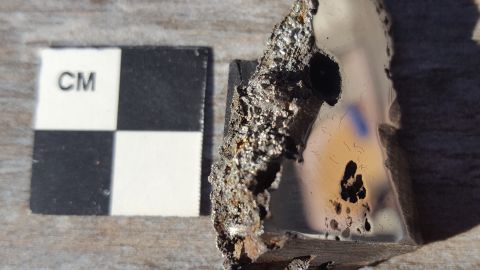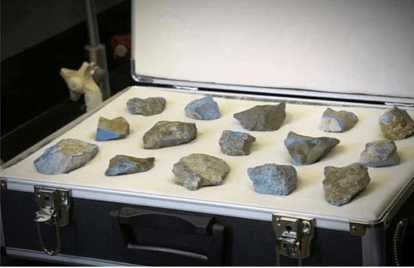
2 never-before-seen Minerals Found in Huge Asteroid that Fell to Earth
A 15-metric ton meteorite crashed in Africa. Now 2 new minerals have been found in it.
Pictured is a sample of the El Ali meteorite found in Somalia. The specimen contains two minerals that don’t naturally form on Earth, scientists said.
Pictured is a sample of the El Ali meteorite found in Somalia. The specimen contains two minerals that don’t naturally form on Earth, scientists said.
By Kristen Rogers, CNN
Scientists have identified two minerals never before seen on Earth in a meteorite weighing 15.2 metric tons (33,510 pounds).
The minerals came from a 70-gram (nearly 2.5-ounce) slice of the meteorite, which was discovered in Somalia in 2020 and is the ninth-largest meteorite ever found, according to a news release from the University of Alberta.
Chris Herd, curator of the university’s meteorite collection, received samples of the space rock so he could classify it. As he was examining it, something unusual caught his eye — some parts of the sample weren’t identifiable by a microscope. He then sought advice from Andrew Locock, head of the university’s Electron Microprobe Laboratory, since Locock has experience describing new minerals.
Pictures From Peter Obi’s Presidential Campaign In Port Harcourt, Rivers State
“The very first day he did some analyses, he said, ‘You’ve got at least two new minerals in there,’” Herd, a professor in the university’s department of Earth and atmospheric sciences, said in a statement. “That was phenomenal. Most of the time it takes a lot more work than that to say there’s a new mineral.”
One mineral’s name — elaliite — derives from the space object itself, which is called the “El Ali” meteorite since it was found near the town of El Ali in central Somalia.
Herd named the second one elkinstantonite after Lindy Elkins-Tanton, vice president of Arizona State University’s Interplanetary Initiative. Elkins-Tanton is also a regents professor in that university’s School of Earth and Space Exploration and the principal investigator of NASA’s upcoming Psyche mission — a journey to a metal-rich asteroid orbiting the sun between Mars and Jupiter, according to the space agency.
“Lindy has done a lot of work on how the cores of planets form, how these iron nickel cores form, and the closest analogue we have are iron meteorites,” Herd said. “It made sense to name a mineral after her and recognize her contributions to science.”
Mass Shooting At Kurdish Center In Paris. 3 Dead, shooter Arrested
The European robotic arm controlled by cosmonaut Anna Kikina surveys the Soyuz MS-22 crew ship after the detection of a leak that cancelled the spacewalk on Wednesday December 14.
NASA and Russia weigh options for astronaut return after spacecraft leak
The International Mineralogical Association’s approval of the two new minerals in November of this year “indicates that the work is robust,” said Oliver Tschauner, a mineralogist and professor of research in the department of geoscience at the University of Nevada, Las Vegas.
“Whenever you find a new mineral, it means that the actual geological conditions, the chemistry of the rock, was different than what’s been found before,” Herd said. “That’s what makes this exciting: In this particular meteorite you have two officially described minerals that are new to science.”
The role of lab-created minerals in discovery
Locock’s quick identification was possible because similar minerals had been synthetically created before, and he was able to match the composition of the newly discovered minerals with their human-made counterparts, according to the University of Alberta release.
Professor Andy Tomkins, left, from Monash University with RMIT University PhD scholar Alan Salek and a ureilite meteor sample.
Meet the mystery diamond from outer space
“Material scientists do this all the time,” said Alan Rubin, a meteorite researcher and former adjunct professor and research geochemist in the department of earth, planetary and space sciences at the University of California, Los Angeles. “They can create new compounds — one, just to see what’s physically possible just as a research interest, and others … will say, ‘We’re seeking a compound that has certain properties for some practical or commercial application, like conductivity or high strain or high melting temperature.
“It’s just fortuitous that a researcher will find a mineral in a meteorite or a terrestrial rock that hasn’t been known before, and then very often, that same compound will have been created previously by material scientists.”
Both new minerals are phosphates of iron, Tschauner said. A phosphate is a salt or ester of a phosphoric acid.
“Phosphates in iron meteorites are secondary products: They form through oxidation of phosphides … which are rare primary components of iron meteorites,” he said via email. “Hence, the two new phosphates tell us about oxidation processes that occurred in the meteorite material. It remains to be seen if the oxidation occurred in space or on Earth, after the fall, but as far as I know, many of these meteorite phosphates formed in space. In either case, water is probably the reactant that caused the oxidation.”
Plague inscription from the Chu Valley region in Kyrgyzstan
The Black Death’s legacy, Neanderthal family ties, and other secrets revealed by ancient DNA in 2022
The findings were presented in November at the University of Alberta’s Space Exploration Symposium. The revelations “broaden our perspective on the natural materials that can be found and can be formed in the solar system,” Rubin said.
The El Ali meteorite the minerals came from appears to have been sent to China in search of a buyer, Herd said.
Meanwhile, the researchers are still analyzing the minerals — and potentially a third one — to find out what the conditions were in the meteorite when the space rock formed. And newly discovered minerals could have exciting implications for the future, he added.
“Whenever there’s a new material that’s known, material scientists are interested too because of the potential uses in a wide range of things in society,” Herd said.
Source: CNN




